
Helen Beatrix Potter was an English writer, illustrator, natural scientist, and conservationist. She is best known for her children's books featuring animals, such as The Tale of Peter Rabbit, which was her first published work in 1902. Her books, including 23 Tales, have sold more than 250 million copies. An entrepreneur, Potter was a pioneer of character merchandising. In 1903, Peter Rabbit was the first fictional character to be made into a patented stuffed toy, making him the oldest licensed character.
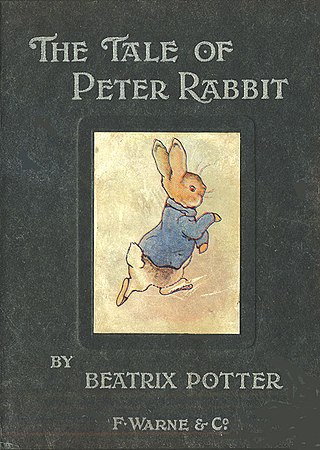
The Tale of Peter Rabbit is a children's book written and illustrated by Beatrix Potter that follows mischievous and disobedient young Peter Rabbit as he gets into, and is chased around, the garden of Mr. McGregor. He escapes and returns home to his mother, who puts him to bed after offering him chamomile tea. The tale was written for five-year-old Noel Moore, the son of Potter's former governess, Annie Carter Moore, in 1893. It was revised and privately printed by Potter in 1901 after several publishers' rejections, but was printed in a trade edition by Frederick Warne & Co. in 1902. The book was a success, and multiple reprints were issued in the years immediately following its debut. It has been translated into 36 languages, and with 45 million copies sold it is one of the best-selling books in history.

The Tale of Samuel Whiskers or The Roly-Poly Pudding is a children's book written and illustrated by Beatrix Potter and first published by Frederick Warne & Co. in October 1908 as The Roly-Poly Pudding. In 1926, it was re-published as The Tale of Samuel Whiskers. The book is dedicated to the author's fancy rat "Sammy" and tells of Tom Kitten's escape from two rats who plan to make him into a pudding. The tale was adapted to animation in 1993.

The Tale of The Flopsy Bunnies is a children's book written and illustrated by Beatrix Potter, and first published by Frederick Warne & Co. in July 1909. After two full-length tales about rabbits, Potter had grown weary of the subject and was reluctant to write another. She realized however that children most enjoyed her rabbit stories and pictures, and so reached back to characters and plot elements from The Tale of Peter Rabbit (1902) and The Tale of Benjamin Bunny (1904) to create The Flopsy Bunnies. A semi-formal garden of archways and flowerbeds in Wales at the home of her uncle and aunt became the background for the illustrations.
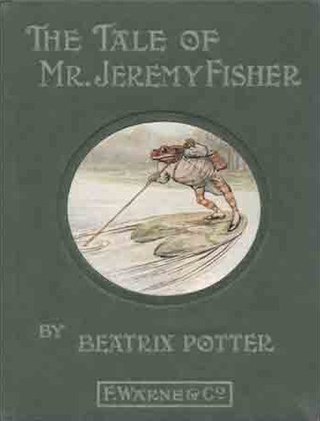
The Tale of Mr. Jeremy Fisher is a children's book, written and illustrated by Beatrix Potter. It was published by Frederick Warne & Co. in July 1906. Jeremy's origin lies in a letter she wrote to a child in 1893. She revised it in 1906, and moved its setting from the River Tay to the English Lake District. The tale reflects her love for the Lake District and her admiration for children's illustrator Randolph Caldecott.
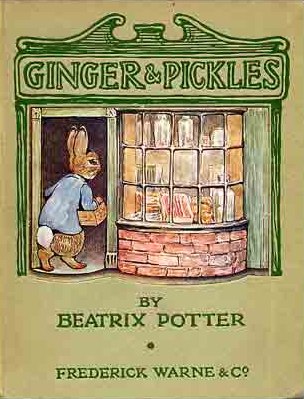
The Tale of Ginger and Pickles is a children's book written and illustrated by Beatrix Potter, and first published by Frederick Warne & Co. in 1909. The book tells of two shopkeepers who extend unlimited credit to their customers and, as a result, are forced to go out of business. It was originally published in a large format which permitted very detailed illustrations and also allowed Potter to include black-and-white vignettes. Potter filled the tale with characters from her previous books. The book was eventually republished in the standard small format of the Peter Rabbit series and was adapted to drama in 1931.

The Tale of Mrs. Tiggy-Winkle is a children's book written and illustrated by Beatrix Potter. It was published by Frederick Warne & Co. in October 1905. Mrs. Tiggy-winkle is a hedgehog washerwoman (laundress) who lives in a tiny cottage in the fells of the Lake District. A human child named Lucie happens upon the cottage and stays for tea. The two deliver freshly laundered clothing to the animals and birds in the neighbourhood. Potter thought the book would be best enjoyed by girls, and, like most girls' books of the period, it is set indoors with a focus on housework.

The Tailor of Gloucester is a Christmas children's book written and illustrated by Beatrix Potter, privately printed by the author in 1902, and published in a trade edition by Frederick Warne & Co. in October 1903. The story is about a tailor whose work on a waistcoat is finished by the grateful mice he rescues from his cat and was based on a real world incident involving a tailor and his assistants. For years, Potter declared that of all her books it was her personal favourite.
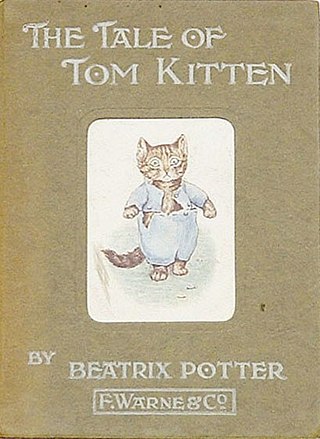
The Tale of Tom Kitten is a children's book, written and illustrated by Beatrix Potter. It was released by Frederick Warne & Co. in September 1907. The tale is about manners and how children react to them. Tabitha Twitchit, a cat, invites friends for tea. She washes and dresses her three kittens for the party, but within moments the kittens have soiled and lost their clothes while scampering about the garden. Tabitha is "affronted". She sends the kittens to bed, and tells her friends the kittens have the measles. Once the tea party is underway however, its "dignity and repose" are disturbed by the kittens romping overhead and leaving a bedroom in disorder.

The Tale of the Pie and the Patty-Pan is a children's book written and illustrated by Beatrix Potter, and published by Frederick Warne & Co. in October 1905. It tells of a cat called Ribby and a tea party she holds for a dog called Duchess. Complications arise when Duchess tries to replace Ribby's mouse pie with her own veal and ham pie, and then believes she has swallowed a small tin pastry form called a patty-pan. Its themes are etiquette and social relations in a small town.
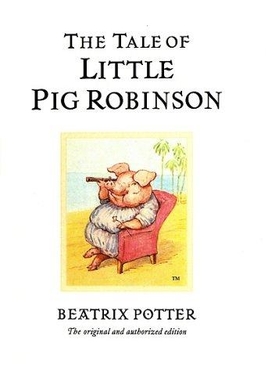
The Tale of Little Pig Robinson is a children's book written and illustrated by Beatrix Potter as part of the Peter Rabbit series. The book contains eight chapters and numerous illustrations. Though the book was one of Potter's last publications in 1930, it was one of the first stories she wrote.

The Tale of Johnny Town-Mouse is a children's book written and illustrated by Beatrix Potter and first published by Frederick Warne & Co. In December 1918. The tale is based on the Aesop fable, "The Town Mouse and the Country Mouse", with details taken from Horace's Satires 2.6.79-117. It tells of a country mouse and a city mouse who visit each other in their respective homes. After sampling the other's way of life, both express a decided preference for their own. The book was critically well received. The Johnny Town-mouse character appeared in a 1971 ballet film, and the tale has been adapted to a BBC television animated series.
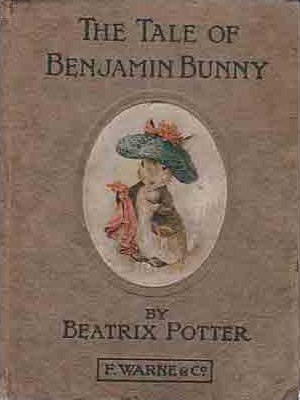
The Tale of Benjamin Bunny is a children's book written and illustrated by Beatrix Potter, and first published by Frederick Warne & Co. in September 1904. The book is a sequel to The Tale of Peter Rabbit (1902), and tells of Peter's return to Mr. McGregor's garden with his cousin Benjamin to retrieve the clothes he lost there during his previous adventure. In Benjamin Bunny, Potter deepened the rabbit universe she created in Peter Rabbit, and, in doing so, suggested the rabbit world was parallel to the human world but complete and sufficient unto itself.

The Tale of Two Bad Mice is a children's book written and illustrated by Beatrix Potter, and published by Frederick Warne & Co. in September 1904. Potter took inspiration for the tale from two mice caught in a cage-trap in her cousin's home and a doll's house being constructed by her editor and publisher Norman Warne as a Christmas gift for his niece Winifred. While the tale was being developed, Potter and Warne fell in love and became engaged, much to the annoyance of Potter's parents, who were grooming their daughter to be a permanent resident and housekeeper in their London home.

The Story of Miss Moppet is a tale about teasing, featuring a kitten and a mouse, that was written and illustrated by Beatrix Potter, and published by Frederick Warne & Co for the 1906 Christmas season. Potter was born in London in 1866, and between 1902 and 1905 published a series of small-format children's books with Warne. In 1906, she experimented with an atypical panorama design for Miss Moppet, which booksellers disliked; the story was reprinted in 1916 in small book format.

The Tale of Timmy Tiptoes is a children's book written and illustrated by Beatrix Potter, and published by Frederick Warne & Co. in October 1911. Timmy Tiptoes is a squirrel believed to be a nut-thief by his fellows, and imprisoned by them in a hollow tree with the expectation that he will confess under confinement. Timmy is tended by Chippy Hackee, a friendly, mischievous chipmunk who has run away from his wife and is camping-out in the tree. Chippy urges the prisoner to eat the nuts stored in the tree, and Timmy does so but grows so fat he cannot escape the tree. He regains his freedom when a storm topples part of the tree. The tale contrasts the harmonious marriage of its title character with the less than harmonious marriage of the chipmunk.

The Story of A Fierce Bad Rabbit is a children’s book written and illustrated by Beatrix Potter, and first published by Frederick Warne & Co. in December 1906. The book tells of a bad little rabbit who forcefully takes another rabbit's carrot, but soon loses his tail and whiskers after being fired upon by a hunter. The book was intended for babies and very young children, and was originally published on a strip of paper that folded into a wallet and was tied with a ribbon. The format was unpopular with booksellers, and eventually reprinted in the standard small book format of the Peter Rabbit library. Although the book sold well, there are not many left in existence. It provides the young child with an introduction to books and the Peter Rabbit universe.

Appley Dapply's Nursery Rhymes is the first of two collections of nursery rhymes written and illustrated by Beatrix Potter. It was first published in 1917. The title character is a brown mouse who takes food out of a cupboard in someone else's house.
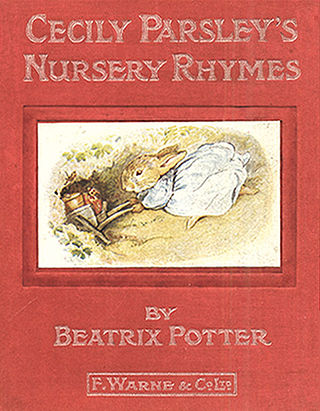
Cecily Parsley's Nursery Rhymes is a children's book written and illustrated by Beatrix Potter, and published by Frederick Warne & Co. in December 1922. The book is a compilation of traditional English nursery rhymes such as "Goosey Goosey Gander", "This Little Piggy" and "Three Blind Mice". The title character is a rabbit who brews ale for gentlemen.

Norman Dalziel Warne was the third son of publisher Frederick Warne, and joined his father's firm Frederick Warne & Co as an editor. In 1900, the company rejected Beatrix Potter's The Tale of Peter Rabbit, but eventually reconsidered and in October 1902, published the book to great success. Norman Warne became Potter's editor and they worked together on several subsequent books and related merchandise, such as soft toys and The Game of Peter Rabbit.




















